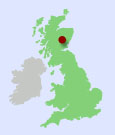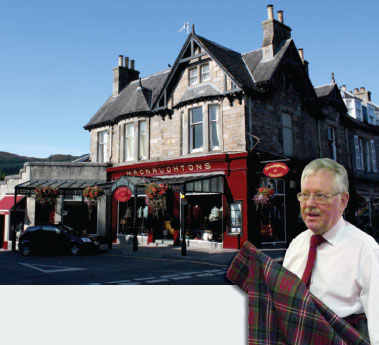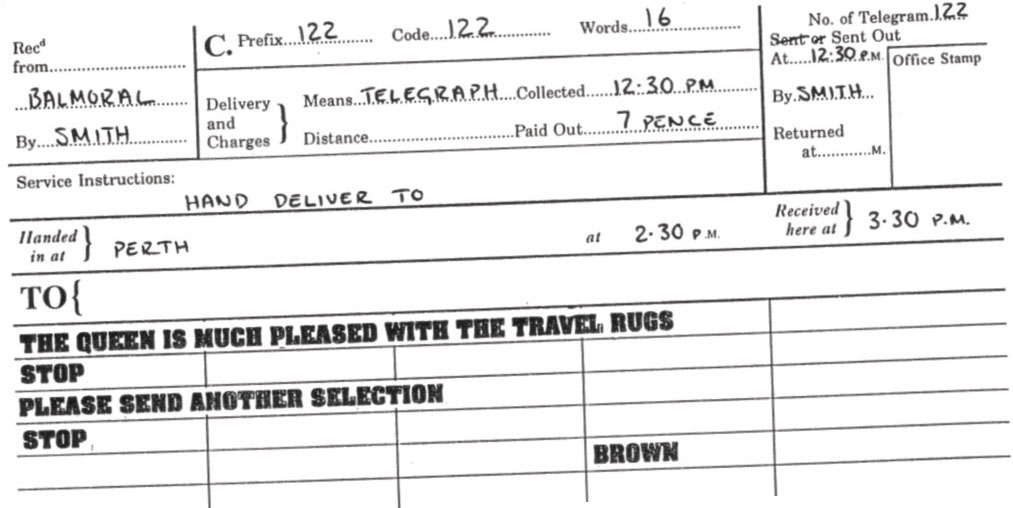
[caption id="KiltedatMacnaughtonsofPitlochrysince1835_Feature" align="aligncenter" width="1024"]

JENNIFER BERRY
[caption id="KiltedatMacnaughtonsofPitlochrysince1835_img1" align="aligncenter" width="115"]

FORBES INGLIS
MENTION SCOTLAND ANYWHERE IN THE WORLD and most people’s thoughts turn to whisky and tartan. Of course, as tartan is generally used to indicate Scottishness, it can be used in various ways. Tartan might be the pattern on a tablecloth or napkin, wallpaper, book cover or even a carpet—but it is most commonly used to make kilts.
Strange as it may seem, the story of the kilt as we know it today is actually less than 200 years old. Although nowadays kilts are on sale at numerous outlets, only a few shops have been trading for any length of time. But one such business, Macnaughtons of Pitlochry, retailers of highland dress, can claim a history stretching back to 1835 and the reign of William IV.
Pitlochry is situated in scenic Highland Perthshire in the very heart of Scotland—a regular winner in the Britain In Bloom competition. It was the coming of the railway in 1863 that opened Pitlochry up for tourism. In those days, most visitors came from England, but now they come from around the globe, still seeking to explore Scotland and take home a souvenir of their trip. A tartan memento for a loved one, whether a necktie or a full kilt outfit, fits the bill perfectly, although if you prefer whisky then Scotland’s smallest distillery, Edradour, situated on the outskirts of the town, can supply that, too.
Originally, tartan was a purely Highland tradition, and the kilt, as we know it today, simply didn’t exist. Clans were more than simply families, as they were bonded, not just by blood, but by the land they held under their chief and that bond generally included military service. The early forms of tartan would simply have been made from what has been described as “wool of many colors,” tinted using the herbs dyes available, and those tartans would not have had the distinct family or clan connections we know today.
The clansmen didn’t wear what we know as the kilt, they wore the philibeag, a long piece of cloth, wrapped around their bodies. Before they went into battle they simply dropped their plaids and charged, wearing only their shirts and bonnets. The members of the various clans stuck a different plant in their bonnets, not for decoration but for identification. Being charged by hundreds of semi-naked Scots sounds horrifying.
Following the 1745 uprising, when the Jacobite followers of the Old Pretender, otherwise known as James VIII, attempted to depose the Hanoverian King George II, the Highland clans who had formed a large portion of the rebel army were suppressed. The hated Disarming Act, aimed to curb the powers of the clan system by prohibiting the carrying of arms and the wearing of tartan, was eventually repealed in 1782. After that, tartan became acceptable.
The modern idea of the kilt, however, was born when King George IV visited Scotland in 1822. The visit, largely orchestrated by Scots’ novelist Sir Walter Scott, saw the rather portly King swathed from head to foot in tartan. In truth, the king looked ridiculous, but where monarchs went fashion soon followed. And when Queen Victoria, with her great love of all things Scottish, came to the throne it became even more popular.
Today there are some 3,500 tartans covering clans, districts, regiments and even soccer clubs. Pitlochry itself has its own tartan, registered in 2010, and countless organizations have identifying tartan, including one for the students of West Point.
[caption id="KiltedatMacnaughtonsofPitlochrysince1835_img2" align="aligncenter" width="379"]

COURTESY OF MACNAUGHTONS OF PITLOCHRY
Iwent to meet David Borland of Macnaughton’s, an expert with decades of experience in tartan and highland dress, to find out more about the wearing of the kilt.
Only three measurements are required. The waist, taken firmly but not tightly at the level of the navel, the fullest part of the hip, and the length, which is taken from two inches above the hip bone to an imaginary point just reaching the top of the knee cap.
When it comes to a choice of tartan, most men take a tartan based on family ties (usually through the male line) or a district tartan. After all, there will be a tartan connected to you in some way, and the cloth required will be in the shop stock or, if necessary, can be obtained from one of the major tartan weavers. Alternatively, you can simply choose a tartan you like. Just to make one thing clear, in Scotland the word plaid doesn’t mean tartan. A plaid is a piece of tartan cloth worn over the shoulder.
The shop supplies the kilt maker with canvas for the parts that are reinforced, as well as buckles and lining, and some four to six weeks later your kilt will be ready. A kilt is made of eight yards of material with the pleats worn at the back. (David Borland says the most common error for those unused to wearing the kilt is to put it on back to front.)
There is much more to the protocol of kilt wearing than that however. Accessories or accoutrements are required depending on when the wearer intends to wear it. Often, kilts are worn to weddings, dances or sometimes just for everyday wear, but, as Borland stressed to me, a kilt is made to be worn.
For everyday wear, a kilt should be worn with a leather or pigskin sporran, lovat green socks and a tweed jacket or even a sweater. Semiformal occasions require a black sealskin sporran, black hose and Argyll jacket. A waistcoat is optional for semiformal wear.
For strictly formal functions the dress code is a sealskin sporran with silver cantle (mounting), Prince Charlie black coatee and vest. Black hose is also correct for formal wear.
[caption id="KiltedatMacnaughtonsofPitlochrysince1835_img3" align="aligncenter" width="1024"]

COURTESY OF MACNAUGHTONS OF PITLOCHRY
Flashes are worn in the socks and, generally, a sgian dubh, a small ceremonial knife, is tucked into one of the socks. Sgian dubh (Gaelic, of course) literally means black knife. The word black in this sense doesn’t refer to the color, it means secret. In more violent times the knife would have been concealed under the armpit. These days it is carried more openly to show friendship, but I wouldn’t advise taking one in hand luggage on a plane.
The supporters of Scotland’s soccer team, the so-called Tartan Army (it has its own tartan), have taken the kilt wherever Scotland plays. They wear kilts of different tartans and lengths as they are often second-hand, along with self-mocking headgear consisting of a tammy, a sort of beret, with obviously fake ginger hair attached, which is known as a jimmy wig. Sadly, the Scots’ team isn’t particularly good these days, so the supporters, particularly at away matches, travel to support their team, have a few drinks and enjoy some good-natured fun.
On the other hand, Scots do take their national dress seriously and many bridegrooms now wear the kilt for their wedding. Neckwear is also important; for everyday use the kilt can be worn with an open-necked shirt or a plain wool tie. A black bow tie is the traditional wear for formal occasions. Personal choice seems to be the order of the day, however, with outfits ranging from the formal to a kilt with an informal Jacobite shirt that laces up the front.
According to traditionalists, tartan, other than a plaid, should never be worn above the waist, so wearing a tartan tie with a kilt is considered wrong. That said, Borland pointed out that a kilt, military wear apart, is not a uniform and should be worn so that the wearer feels comfortable. If you wish, you can certainly wear a tartan necktie with tartan trousers, or trews as they are known, or even with a conventional business suit.
One thing to be clear about is that kilt is not a skirt. Ladies can wear long tartan skirts, but that is a different matter altogether.
Asked about dos and don’ts, Borland had some suggestions. Choose a well-established company and remember that mail order facilities are available from most kilt retailers. A good kilt and accessories will be expensive; and at the top end of the market a full outfit will cost more than £1,000. But you get what you pay for; looked after properly, a kilt will last a lifetime and, fashion wise, doesn’t date.
Also, don’t rely on the internet for accurate color—the actual colors may be quite different!
Listen to the expert, not hearsay—there are many myths about kilt wearing. The biggest myth of all is probably about what, if anything, a Scotsman wears under his kilt. Now, it may still be the practice in the Highland regiments for men to wear nothing under their kilt, but taking hygiene, cleanliness and simple practicality into account Borland recommends dark underpants.
Don’t expect to find everyone in Scotland to be wearing the kilt. They are now commonly worn at weddings and other formal occasions as more younger Scots take a pride in their country. For those abroad with Scottish roots, the kilt is part of their heritage, too, and there is no reason why they too can’t wear a kilt with pride.
Macnaughtons of Pitlochry, masters of their craft for almost 200 years, are still proud of their reputation—as the current proprietor was only too keen to show me. So, let’s leave the last word to the shop’s most distinguished customer, Queen Victoria. The goods sent to Balmoral were tartan travel rugs. Such was the Queen’s delight with her purchases that she had a telegram, sadly undated, sent to Macnaughtons by her friend and servant John Brown on her behalf. Now, there’s a real piece of British heritage!
[caption id="KiltedatMacnaughtonsofPitlochrysince1835_img4" align="aligncenter" width="1024"]

FORBES INGLIS
Wearing the Kilt
Editor Dana Huntley models the hand-pleated kilt in the tartan of Ancient Red Gordon, made for him by MacNaughtons of Pitlochry in 1983. Called out are the customary accessories: the sporran, sgian dubh and flashes.
[caption id="KiltedatMacnaughtonsofPitlochrysince1835_img5" align="aligncenter" width="1013"]

© JENNIFER E. BERRY





Comments